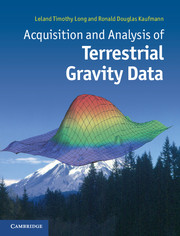Book contents
- Frontmatter
- Contents
- Preface
- 1 Gravitational attraction
- 2 Instruments and data reduction
- 3 Field acquisition of gravity data
- 4 Graphical representation of the anomalous field
- 5 Manipulation of the gravity field
- 6 Interpretation of density structure
- 7 The inversion of gravity data
- 8 Experimental isostasy
- A Appendix ACommon definitions and equations in potential theory
- B Appendix BGlossary of symbols
- References
- Index
3 - Field acquisition of gravity data
Published online by Cambridge University Press: 05 February 2013
- Frontmatter
- Contents
- Preface
- 1 Gravitational attraction
- 2 Instruments and data reduction
- 3 Field acquisition of gravity data
- 4 Graphical representation of the anomalous field
- 5 Manipulation of the gravity field
- 6 Interpretation of density structure
- 7 The inversion of gravity data
- 8 Experimental isostasy
- A Appendix ACommon definitions and equations in potential theory
- B Appendix BGlossary of symbols
- References
- Index
Summary
Introduction
Gravity data acquisition is an exercise in the documentation of detail and common sense. The practicality of developing detailed survey plans beforehand depends on the type of survey. A survey over a small area where the locations of data points can be determined in advance could benefit from a site visit and detailed preplanning. However, for more widely spaced data, such as in regional surveys for crustal-scale structures, the observation points most likely have not been visited before the survey and their exact location and condition may not be determined until the sites are visited. For these surveys, planning in detail for each site is rarely practical because unanticipated legal and physical barriers to access of survey locations may change with time. In addition, the preservation of safe working conditions related to traffic or weather in the field often requires on-the-spot changes in survey plans. With or without pre-planning, detailed notes on the survey should be taken at the time of data acquisition. Complete and detailed notes can significantly reduce data reduction errors and are a necessary component of a quality-assurance program. Without such notes, correction of anomalous points would require a repeat occupation of the field site. Guidelines for documenting field acquisition, either in a notebook or in a computer will help to maintain complete and consistent notes and will speed data reduction.
The field survey techniques must accommodate the size and terrain of the survey area and the available instruments. Each survey will be unique and could require some modifications to survey technique. However, the data documentation should be consistent to encourage a systematic reduction process and record of quality control. Documentation starts with familiarizing the survey crew with the area through a site visit, perhaps when establishing base stations, or by examining maps and aerial photographs. Interactive web sites provide a useful tool for examination of the acquisition area. The importance of documentation and its contribution to efficiency is fully realized when a survey is interrupted or when problems in meter drift or locations are discovered after the survey team has left the field. Although GPS systems and meters equipped with computers reduce the need for hard copies, backups should be designed to prevent loss of data in power failures or computer crashes. Ultimately, a backup of essential data should be printed in a format easily interpreted by optical character recognition.
- Type
- Chapter
- Information
- Acquisition and Analysis of Terrestrial Gravity Data , pp. 41 - 47Publisher: Cambridge University PressPrint publication year: 2013



